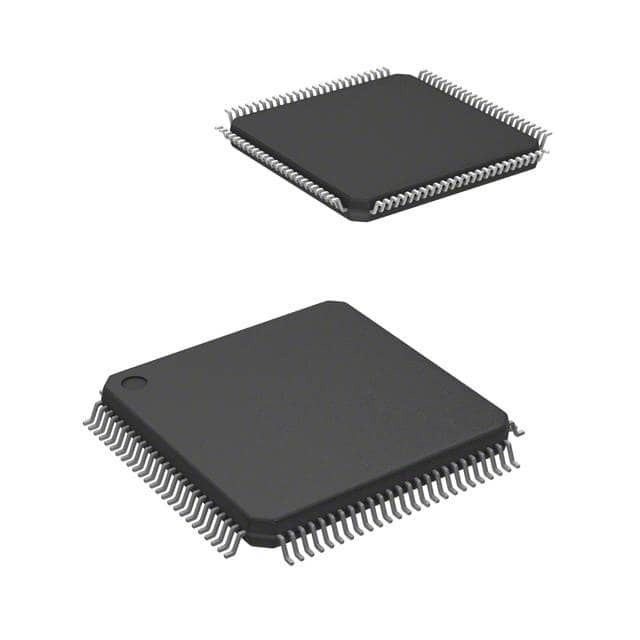EZ80F93AZ020EG
Product Overview
Category
The EZ80F93AZ020EG belongs to the category of microcontrollers.
Use
This microcontroller is commonly used in various electronic devices and systems for control and processing purposes.
Characteristics
- High-performance microcontroller with advanced features
- Low power consumption
- Compact size
- Wide operating voltage range
- Robust design for reliable operation
Package
The EZ80F93AZ020EG is available in a compact package, suitable for surface mount technology (SMT) assembly.
Essence
The essence of this microcontroller lies in its ability to provide efficient control and processing capabilities in a small form factor.
Packaging/Quantity
The EZ80F93AZ020EG is typically packaged in reels or trays, with a quantity of 1000 units per package.
Specifications
- Architecture: 8-bit
- Clock Speed: Up to 20 MHz
- Flash Memory: 32 KB
- RAM: 2 KB
- Operating Voltage: 2.7V to 5.5V
- I/O Pins: 32
- Communication Interfaces: UART, SPI, I2C
- Timers/Counters: 4
- ADC Channels: 8-bit, 8 channels
- Operating Temperature Range: -40°C to +85°C
Detailed Pin Configuration
The EZ80F93AZ020EG has a total of 44 pins, which are assigned for various functions such as I/O, power supply, communication, and programming. The detailed pin configuration can be found in the datasheet provided by the manufacturer.
Functional Features
- High-speed processing capability
- Multiple communication interfaces for data exchange
- On-chip memory for program storage and data handling
- Built-in timers/counters for precise timing operations
- Analog-to-digital converter (ADC) for sensor interfacing
- Interrupt handling mechanism for real-time event processing
Advantages and Disadvantages
Advantages
- High-performance microcontroller suitable for demanding applications
- Low power consumption for energy-efficient operation
- Compact size allows for integration in space-constrained designs
- Wide operating voltage range provides flexibility in power supply options
- Robust design ensures reliable operation even in harsh environments
Disadvantages
- Limited memory capacity compared to higher-end microcontrollers
- Relatively fewer I/O pins for extensive peripheral connectivity
- Higher cost compared to lower-end microcontrollers with similar features
Working Principles
The EZ80F93AZ020EG operates based on the principles of digital logic and microcontroller architecture. It executes instructions stored in its internal flash memory, processes data, and controls external devices through its I/O pins. The microcontroller communicates with other devices using various communication interfaces and performs tasks according to the programmed instructions.
Detailed Application Field Plans
The EZ80F93AZ020EG finds applications in a wide range of fields, including but not limited to: - Industrial automation - Consumer electronics - Automotive systems - Medical devices - Home appliances - Internet of Things (IoT) devices
Its versatility and performance make it suitable for controlling and monitoring tasks in these application fields.
Detailed and Complete Alternative Models
Some alternative models that offer similar functionality to the EZ80F93AZ020EG include: - ATmega328P by Microchip Technology - STM32F103C8T6 by STMicroelectronics - PIC18F4520 by Microchip Technology - MSP430G2553 by Texas Instruments
These alternatives provide comparable features and can be considered based on specific project requirements.
In conclusion, the EZ80F93AZ020EG is a high-performance microcontroller with advanced features, suitable for a variety of applications. Its compact size, low power consumption, and robust design make it a reliable choice for control and processing tasks. However, its limited memory capacity and I/O pins should be considered when selecting this microcontroller for specific projects.
Senaraikan 10 soalan dan jawapan biasa yang berkaitan dengan aplikasi EZ80F93AZ020EG dalam penyelesaian teknikal
Sure! Here are 10 common questions and answers related to the application of EZ80F93AZ020EG in technical solutions:
Q: What is the EZ80F93AZ020EG microcontroller used for? A: The EZ80F93AZ020EG is a microcontroller primarily used for embedded systems and industrial applications.
Q: What is the maximum clock frequency supported by the EZ80F93AZ020EG? A: The EZ80F93AZ020EG supports a maximum clock frequency of 50 MHz.
Q: How much flash memory does the EZ80F93AZ020EG have? A: The EZ80F93AZ020EG has 512 KB of flash memory for program storage.
Q: Can I expand the memory of the EZ80F93AZ020EG? A: Yes, the EZ80F93AZ020EG supports external memory expansion through its memory interface.
Q: What peripherals are integrated into the EZ80F93AZ020EG? A: The EZ80F93AZ020EG includes features such as UARTs, SPI, I2C, timers, PWM, ADC, and GPIO pins.
Q: Does the EZ80F93AZ020EG support Ethernet connectivity? A: Yes, the EZ80F93AZ020EG has an integrated Ethernet MAC controller for network connectivity.
Q: Can I use the EZ80F93AZ020EG for real-time applications? A: Yes, the EZ80F93AZ020EG offers real-time performance with its built-in hardware timers and interrupt capabilities.
Q: What development tools are available for programming the EZ80F93AZ020EG? A: Zilog provides a comprehensive software development kit (SDK) that includes an IDE, compiler, debugger, and programmer.
Q: Is the EZ80F93AZ020EG suitable for low-power applications? A: Yes, the EZ80F93AZ020EG offers power-saving features such as sleep modes and clock gating to minimize power consumption.
Q: Can I use the EZ80F93AZ020EG in harsh environments? A: Yes, the EZ80F93AZ020EG is designed to operate reliably in industrial environments with extended temperature ranges and robustness against noise and vibrations.
Please note that these answers are general and may vary depending on specific application requirements and implementation details.


